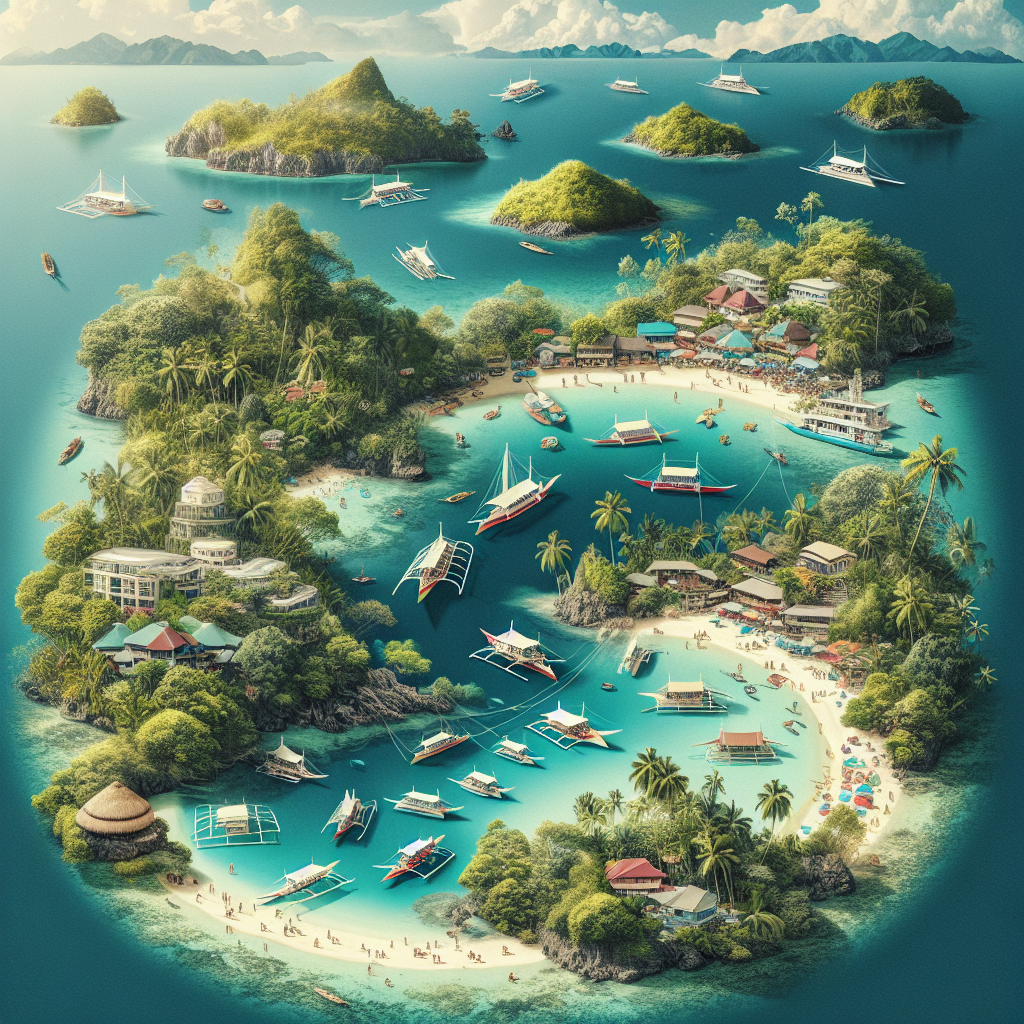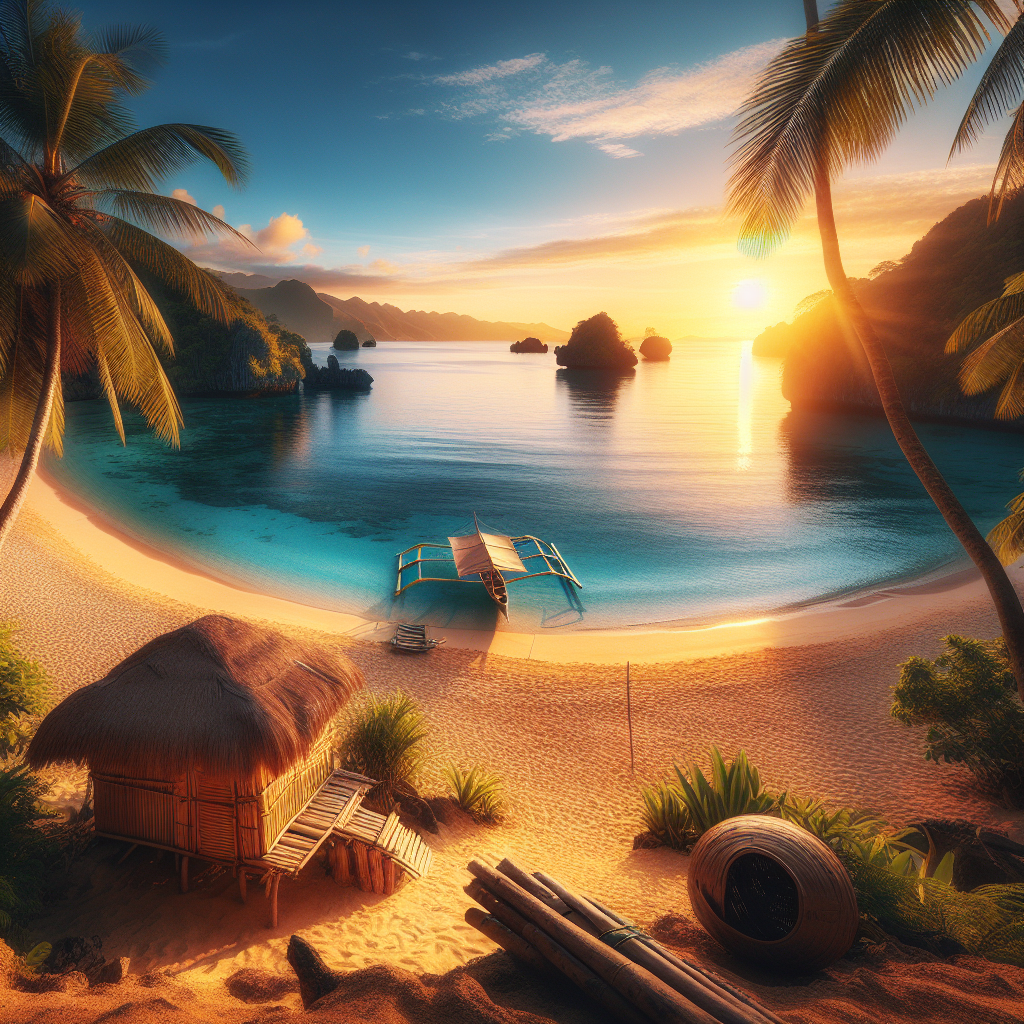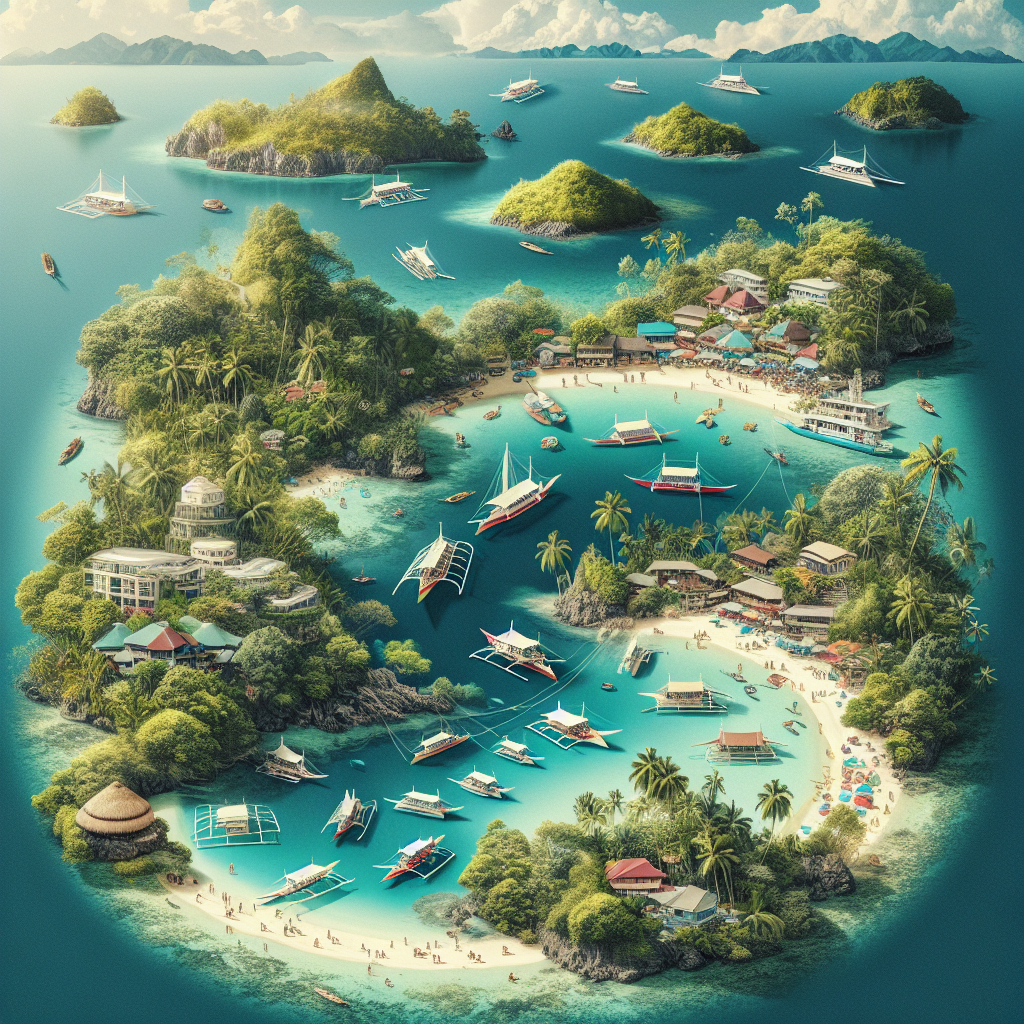Embark on an unforgettable adventure as you explore the stunning archipelago of the Philippines through the exhilarating experience of island hopping. Get ready to immerse yourself in the crystal-clear waters, vibrant coral reefs, and picturesque landscapes that make up this tropical paradise. With this comprehensive guide, you’ll discover the hidden gems, must-visit islands, and practical tips to ensure a seamless and unforgettable island-hopping journey in the Philippines. So pack your swimsuit, grab your snorkel, and get ready to set sail on the vacation of a lifetime.

When to Go
Peak Season
The peak season for island hopping in the Philippines is during the dry months from November to April. During this time, you can expect sunny weather and calm seas, making it perfect for snorkeling, diving, and other water activities. The popular islands can get crowded during this season, so it’s advisable to book accommodations and activities in advance.
Shoulder Season
The shoulder season, which falls between May to June and September to October, is a great time to visit the Philippines for island hopping. The weather is still generally good, with occasional rain showers, but the tourist crowds are significantly smaller compared to the peak season. This means you can enjoy the islands without feeling overwhelmed by other tourists.
Low Season
The low season, which takes place from July to August, is the rainy season in the Philippines. This is when typhoons can occur, resulting in rough seas and heavy rainfall. While island hopping during this time can be a bit challenging, it also has its advantages. The prices for accommodations and activities are often significantly lower, and you may be able to find great deals. If you don’t mind a little rain, the low season can be a more budget-friendly option.
Choosing the Islands
Popular Islands
The Philippines is home to some of the most beautiful islands in the world, and there are a few that are particularly popular among tourists. Boracay, known for its white sand beaches and vibrant nightlife, is a must-visit destination. Palawan, with its stunning limestone cliffs and crystal-clear waters, is another popular choice. Cebu and Bohol offer a mix of cultural attractions and natural wonders, making them great options as well.
Hidden Gems
If you’re looking for a more off-the-beaten-path experience, the Philippines has plenty of hidden gems to explore. Siquijor Island boasts pristine beaches, enchanting waterfalls, and a laid-back atmosphere. Siargao Island, known as the surfing capital of the Philippines, offers world-class waves and a chilled-out island vibe. Camiguin Island, often referred to as the “Island Born of Fire,” is known for its volcanic landscapes and natural wonders.
Islands for Adventure Seekers
For adrenaline junkies, there are several islands in the Philippines that offer thrilling adventure activities. Mindoro Island, specifically Puerto Galera, is a popular destination for diving and snorkeling enthusiasts. Negros Island, particularly Apo Island, is renowned for its vibrant coral reefs and opportunities for swimming with sea turtles. If you’re into hiking and trekking, Luzon’s Batanes Islands provide stunning landscapes and challenging trails.
Islands for Relaxation
If your main goal is to unwind and relax, there are many islands in the Philippines that offer tranquil settings and peaceful atmospheres. Panglao Island in Bohol is known for its beautiful beaches and luxurious resorts, perfect for a rejuvenating vacation. Camiguin Island, with its natural hot springs and spa resorts, is another excellent choice for relaxation. Malapascua Island in Cebu is famous for its calm waters and serene ambiance.
Islands for Cultural Immersion
If you’re interested in immersing yourself in the local culture and traditions of the Philippines, there are several islands that offer unique cultural experiences. Panay Island, particularly the province of Iloilo, is known for its colorful festivals and historic churches. Bantayan Island in Cebu celebrates its rich history and culture through traditional music and dance performances. Mindanao, the southernmost island group, offers a diverse mix of indigenous cultures and a chance to explore unique traditions.
Planning Your Itinerary
Duration of Trip
The duration of your island hopping trip in the Philippines will depend on how many islands you want to visit and the activities you plan to do. A minimum of one week is recommended to explore and enjoy the beauty of at least a few islands. For a more comprehensive experience, two to three weeks would be ideal.
Number of Islands
The Philippines is made up of thousands of islands, so it’s important to narrow down your choices based on your preferences and available time. It’s advisable to select a few islands and spend enough time in each to fully appreciate their beauty and attractions. Trying to visit too many islands in a short period can lead to a rushed and tiring experience.
Travel Routes
There are several common travel routes for island hopping in the Philippines, depending on your starting point and desired destinations. One popular route is the Palawan route, which includes the islands of Coron, El Nido, and Puerto Princesa. Another popular option is the Visayas route, which includes Cebu, Bohol, and Siquijor. The choice of route will depend on your preferences and the islands you wish to explore.
Transportation Options
To get from one island to another in the Philippines, there are various transportation options available. Domestic flights are the quickest and most convenient way to travel between islands. However, if you have more time and want a more scenic experience, ferries and boats are also popular choices. Some islands have their own airports, while others can only be accessed by boat.
Cost Considerations
When planning your island hopping trip in the Philippines, it’s important to consider the costs involved. Accommodation, transportation, meals, and activities can vary in price depending on the location and level of luxury. It’s advisable to research and budget accordingly to ensure a smooth and enjoyable trip. Keep in mind that the low season typically offers more affordable prices for accommodations and activities.
Packing Essentials
Lightweight Clothing
When visiting the Philippines, it’s essential to pack lightweight and breathable clothing due to the tropical climate. Opt for loose-fitting clothes made of lightweight fabrics like cotton or linen. Long-sleeved shirts and pants are also recommended to protect your skin from the sun and insects.
Swimwear and Beach Accessories
Don’t forget to pack your swimwear and beach accessories for your island hopping adventure. Bring a few swimsuits, cover-ups, and beach towels. Water shoes or sandals are also useful for protecting your feet when exploring rocky shores.
Sun Protection
The tropical sun in the Philippines can be intense, so be sure to pack sun protection essentials. Carry a wide-brimmed hat, sunglasses, and sunscreen with a high SPF. It’s also a good idea to bring aloe vera gel or after-sun lotion in case of sunburn.
Insect Repellent
To protect yourself from mosquitoes and other biting insects, bring a reliable insect repellent. Look for one that contains DEET or other effective active ingredients.
Comfortable Footwear
Comfortable footwear is crucial for island hopping, especially when exploring beaches and trails. Pack a pair of sturdy walking shoes or sandals with good arch support. Flip-flops or beach sandals are also useful for casual outings.
Reusable Water Bottle
Staying hydrated is important when exploring the islands, so remember to bring a reusable water bottle. This allows you to refill it with clean drinking water and reduces the use of single-use plastic bottles, which is better for the environment.
First Aid Kit
It’s always a good idea to have a basic first aid kit with you during your travels. Include items like band-aids, antiseptic cream, pain relievers, and any necessary prescription medications.
Cash and Cards
While credit and debit cards are widely accepted in major tourist areas, it’s advisable to have some cash on hand, especially when visiting smaller islands or local markets. ATMs may not be readily available in some areas, so it’s best to have cash for emergencies or when electronic payment options are limited.

Accommodation Options
Resorts
Resorts are a popular choice for accommodations in the Philippines, especially on the more developed and touristy islands. They offer a range of amenities, including swimming pools, restaurants, and organized activities. Resorts range from budget-friendly options to luxurious, all-inclusive properties.
Guesthouses and Homestays
For a more authentic and budget-friendly experience, consider staying in guesthouses or homestays. These accommodations are typically run by locals and offer a more intimate and personalized experience. It’s a great way to immerse yourself in the local culture and interact with friendly hosts.
Island Camping
For adventurous travelers, camping on the islands can be a unique and unforgettable experience. Many islands in the Philippines have designated camping areas where you can pitch a tent and sleep under the stars. Just make sure to follow local regulations and leave no trace to protect the environment.
Activities and Attractions
Snorkeling and Diving
The Philippines is a paradise for snorkeling and diving enthusiasts. With its diverse marine life and vibrant coral reefs, you’ll have the opportunity to explore breathtaking underwater ecosystems. Popular spots for snorkeling and diving include Apo Reef in Mindoro, Tubbataha Reefs Natural Park in Palawan, and Moalboal in Cebu.
Island Hopping Tours
Island hopping tours are a must-do activity in the Philippines, allowing you to visit multiple islands and discover their unique beauty. These tours often include stops at stunning beaches, hidden lagoons, and panoramic viewpoints. Some popular island hopping destinations include El Nido and Coron in Palawan, and the Hundred Islands in Pangasinan.
Water Sports
From surfing to paddleboarding, the Philippines offers a wide range of water sports for adrenaline junkies. Siargao Island is famous for its world-class surfing waves, attracting surfers from around the globe. Boracay and Subic Bay also offer excellent opportunities for water sports like kitesurfing, jet skiing, and parasailing.
Hiking and Trekking
For nature lovers, the Philippines offers spectacular hiking and trekking opportunities. Mt. Pulag in Luzon and Mt. Apo in Mindanao are popular choices for trekking enthusiasts, offering stunning views and challenging trails. The Chocolate Hills in Bohol and the Taraw Cliff in El Nido are also worth exploring.
Cultural Experiences
Immerse yourself in the rich culture and traditions of the Philippines by participating in cultural experiences. Attend local festivals, such as the Ati-Atihan Festival in Kalibo and the Panagbenga Festival in Baguio, to witness colorful parades and traditional performances. Visit historical sites, like the Intramuros in Manila and the Spanish-era churches in Iloilo, to learn about the country’s colonial past.
Wildlife Encounters
The Philippines is home to a diverse range of wildlife, including unique species found nowhere else in the world. Visit the Tarsier Sanctuary in Bohol to see the world’s smallest primate up close. Go whale shark watching in Oslob, Cebu, for a chance to swim alongside these gentle giants. Don’t forget to explore the lush rainforests of Palawan, which are teeming with exotic birds, monkeys, and other wildlife.
Food and Dining
Local Cuisine
The Philippines is known for its flavorful and diverse cuisine, influenced by its rich history and various cultural traditions. Don’t miss out on trying classic Filipino dishes such as adobo (marinated meat cooked in vinegar and soy sauce), sinigang (sour soup), and lechon (roast pig). Each region also has its own specialties, so be sure to sample local delicacies wherever you go.
Seafood Delicacies
Being an archipelago, the Philippines offers an abundance of fresh seafood. Indulge in mouthwatering dishes like grilled squid, shrimp in coconut milk (gambas), and crispy fried fish. If you’re feeling adventurous, try balut, a boiled duck embryo considered a delicacy in the country.
Street Food
Exploring the local street food scene is a must when visiting the Philippines. From skewered grilled meat (isaw) to fried spring rolls (lumpia), you’ll find a wide variety of delicious and affordable snacks. Dive into a plate of chicken or pork barbecue, or satisfy your sweet tooth with a serving of halo-halo, a refreshing dessert made with crushed ice, sweet beans, fruits, and topped with leche flan.
Restaurant Recommendations
While street food is abundant and delicious, there are also many fantastic restaurants in the Philippines that offer a mix of local and international cuisines. In Boracay, try the famous seafood buffet at D’Talipapa Market or indulge in Filipino fusion dishes at Mesa Filipino Moderne. In Palawan, sample mouthwatering grilled dishes at KaLui in Puerto Princesa or enjoy fresh seafood at El Nido Boutique & Art Café.
Safety Tips
Swimming and Water Safety
When swimming in the Philippines, it’s important to be cautious and aware of the ocean conditions. Always swim in designated areas and follow the instructions of lifeguards. Be aware of strong currents and rip tides, especially during the rainy season. If you’re not a confident swimmer, consider wearing a life vest or using flotation devices.
Sun Safety
The sun in the Philippines can be intense, so take precautions to protect yourself from sunburn and heatstroke. Wear sunscreen with a high SPF, and reapply it regularly, especially after swimming. Seek shade during the hottest part of the day, wear protective clothing, and stay hydrated by drinking plenty of water.
Beware of Scams
As with any travel destination, it’s important to be vigilant and aware of potential scams. Be cautious of people offering unsolicited services or deals that sound too good to be true. Avoid giving personal or financial information to unknown individuals. It’s always a good idea to research and book activities and accommodations from reputable sources.
Emergency Contacts
Before your trip, make a note of important emergency contacts. Save the contact information for the local police, fire department, and hospitals in your phone or on a written note. It’s also a good idea to have the contact information for your embassy or consulate in case of any emergencies or unforeseen circumstances.
Responsible Tourism
Respect for Local Culture and Traditions
When visiting the Philippines, it’s important to respect and honor the local culture and traditions. Learn about the customs and etiquette of the places you’ll be visiting and follow them accordingly. Dress modestly when visiting religious or culturally significant sites, and always ask for permission before taking photos of locals.
Protection of Marine Life
The Philippines is home to some of the world’s most beautiful coral reefs and marine ecosystems. It’s crucial to protect and preserve these fragile environments. Avoid stepping on or touching the corals when snorkeling or diving, and never collect or disturb marine life. Use reef-safe sunscreen to minimize any harmful impacts.
Proper Waste Disposal
Dispose of your waste properly and responsibly when visiting the islands. Avoid littering and always use designated trash bins. If there are no trash bins available, carry your trash with you until you find a suitable place to dispose of it. Consider bringing a reusable bag for shopping to reduce the use of plastic bags.
Supporting Local Communities
Make an effort to support local communities during your island hopping adventure. Patronize local businesses, such as restaurants, markets, and souvenir shops. Consider booking tours and activities with local operators who contribute to the local economy. Engage in responsible tourism practices that benefit the communities and minimize negative impacts on the environment.
Useful Phrases and Language Tips
Basic Greetings
Learning a few basic greetings in the local language can go a long way in connecting with the locals. Practice saying “hello” (kamusta), “thank you” (salamat), and “excuse me” (paumanhin). Don’t be afraid to try out these phrases, as the locals will appreciate your efforts.
Asking for Directions
When exploring the islands, you may need to ask for directions. Learn how to ask basic questions like “Where is the nearest beach?” (Saan ang pinakamalapit na beach?), or “How do I get to the hotel?” (Paano ako makakarating sa hotel?).
Ordering Food and Drinks
Sampling local cuisine is a big part of the island hopping experience, so knowing how to order food and drinks can be helpful. Familiarize yourself with phrases such as “What do you recommend?” (Ano ang inirerekomenda niyo?) and “One serving of adobo, please” (Isang serving ng adobo, pakisuyo).
Common Expressions
Learning a few common expressions can help you navigate different situations. Practice phrases like “I don’t understand” (Hindi ko maintindihan), “Can you help me?” (Pwede mo ba akong tulungan?), and “Where is the bathroom?” (Saan ang banyo?).
By following this comprehensive guide, you’ll be well-prepared to embark on an amazing island hopping adventure in the Philippines. Whether you’re seeking adventure, relaxation, or cultural immersion, the diverse and beautiful islands of the Philippines have something for everyone. Pack your essentials, plan your itinerary, and get ready for an unforgettable experience in this tropical paradise. Happy island hopping!

